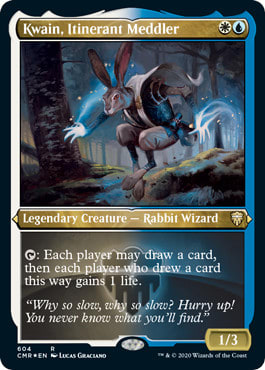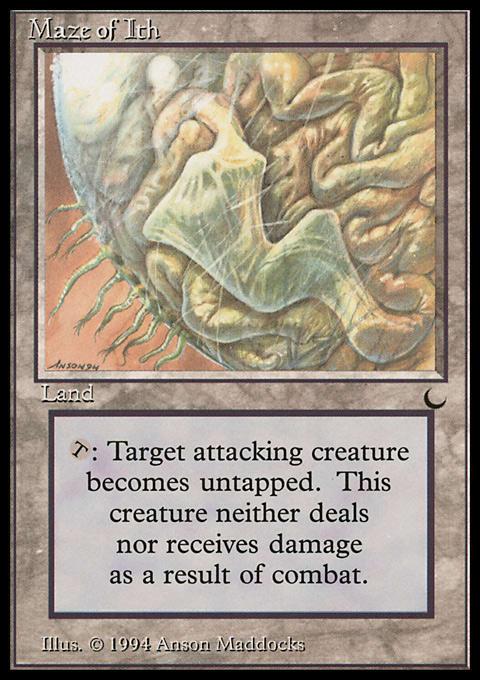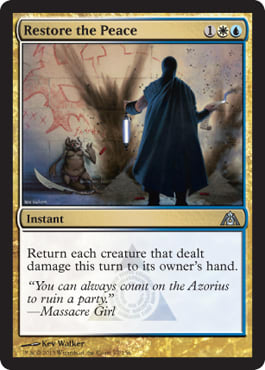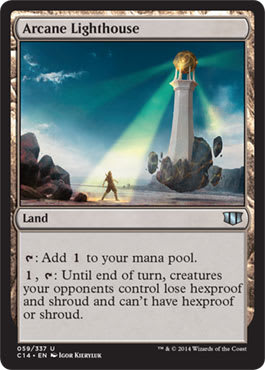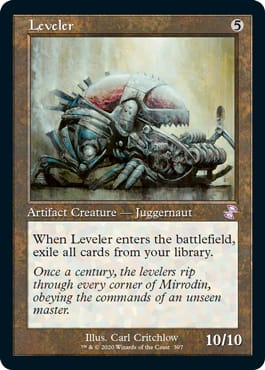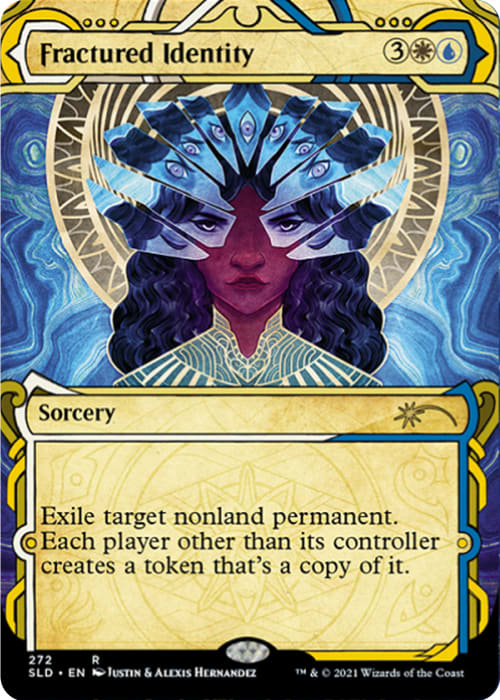
The Duel After The Masquerade by Jean-Leon Gerome (1857). Will Kenrith by Anna Steinbauer.
Last week I shared the story of my first few games with Averna, the Chaos Bloom. The deck won its second game, but even though I had a fantastic time I wasn't actually the player who seemed to be having the best time. A friend who was borrowing my brand new Kwain, Itinerant Meddler deck spent much of the game just delighted at how much fun he was having.
I built Kwain, aka "Bunny Hugs," as an experiment in a different approach to playing Commander. The goal when playing this deck is to help everyone draw cards and to try to make sure that everyone has fun, but also to keep anyone from winning or from killing you. The deck has a wincon, but the goal really isn't to try to win the game. My tablemate actually conceded the game to me once we were the only two players left rather than take another few turns to reach what felt like a forgone conclusion. He had a blast spending most of the game screwing with everyone's attempts to knock each other out - including several of my own alpha strikes.
My idea for Kwain was to have a deck to pivot to if I had just won a game and I was in the mood to play the next game with little to no focus on trying to win. The key to playing this deck happens to be the key to playing and winning Commander games. Even if Kwain doesn't happen to be built with a goal of trying to win - it's all about removal.
Meet Kwain, Itinerant Meddler
In the short list of great "hug" commanders in EDH, Kwain is the only one in just two colors. Phelddagrif, the O.G. of hug commanders is built around being able to give your opponents life, card draw or hippo tokens, and is in Bant. Zedruu, the Greathearted is designed around giving your permanents to opponents and is in Jeskai. The 2016 non-Black four-color legendary Kynaios and Tiro of Meletis is built around helping your opponents draw and/or ramp more quickly. Kwain being in two colors is a limitation, but sometimes restrictions breed creativity.
The fact that Kwain's ability is a "may" ability means that you can't just combo off to force your opponents to draw their entire decks and lose the game. They can always choose not to draw, for instance if someone flashes in a Notion Thief.
Blue and White are great colors for powerful interaction. You can exile and destroy permanents. You can put attacking armies back into their controller's hand. You can stop someone from trying to win the game by just countering their wincon. You might not be in great colors for some facets of the game, but if you've built your deck right and know how to play control, you should have a good shot at being able to frustrate your opponents' attempts to win the game for quite some time.
You might be wondering why anyone would play a commander like Kwain. Helping your opponents to draw cards isn't exactly a great plan in multiplayer Magic. Ideally you want your opponents to have less life and less cards in hand, not more.
The first thing is that this build isn't really about winning. You're the goaltender, and while you might someday manage to score a goal yourself, the point is to keep anyone else from winning.
Playing a deck like "Bunny Hugs" will force you to focus on being very careful with your interaction. You're not hard to kill. You might have some pillowfort cards like Ghostly Prison or Propaganda on the field, but your game plan isn't built around overwhelming your opponents. If you mess with them too much, they'll just turn on you, so you need to be very thoughtful about how and when you stop them from doing what they want to do.
The game plan is to help everyone draw cards for as long as they're not attacking you. If you are drawing them cards, giving them life and not presenting a scary boardstate, they are more likely to leave you alone. That's what you want. You're also setting your opponents up to be better able to control each other and stop each other from winning. Sure, you'll jump in with an Aetherspouts or a Settle the Wreckage if a tablemate you like is about to die, but your mission isn't really to meddle in every play. Your goal is to be the last line of defense and to keep the people you like playing with - hopefully all of your tablemates - from getting knocked out.
The Art of Removal
I have won more than a few games as the result of my tablemates not being careful enough about using their interaction.
Just last month I was able to combo off in part because an opponent who is a good player made a rash decision and chose to cast a retaliatory Cyclonic Rift. I was playing a Shu Yun, the Silent Tempest deck built around infinite combos to take advantage of the prowess mechanic that a lot of Monks happen to have. I had a meager boardstate and wasn't yet a threat, but when I went and overloaded a Rift, one of my tablemates was annoyed that I wasn't going to lose my board so they overloaded a Rift in response. It was actually pretty funny. Everyone picked up their nonland permanents and a turn later as we were all rebuilding, I had the first half of the Dramatic Scepter combo in hand and two turns after the Rift I topdecked the second half. I was able to combo off and make Shu Yun arbitrarily large. The cherry on top of my Shu Yun sundae was my favorite red finisher, Chandra's Ignition. Maybe the table wouldn't have been able to stop me anyways, but having that Cyclonic Rift in hand could have given them a chance.
It's annoying to take non-lethal damage, and it can be frustrating to see an opponent squeeze value out of powerful cards turn after turn, but it's really important to ask yourself one simple question when deciding whether or not to step in and deal with something that might initially look like a problem.

There isn't always an obvious answer to this question.
If you can sit back, look at the situation and can answer "no", you should really consider keeping your removal or interaction in hand.
If you use a Krosan Grip on a Sol Ring because its owner ran away with the previous game and then you end up losing to an Aetherflux Reservoir or someone plays Rings of Brighthearth and Basalt Monolith and wins off of infinite mana, you'll only have yourself to blame. Unless you're running a ridiculous amount of removal, it's nearly always better to keep your powder dry and wait for the truly game ending threats.
Against an aggressive deck in a multiplayer game, you might think a little early discouragement can convince an opponent to put their attention somewhere else. In practice I find it's better to let them hit you early on. In casual play an opponent will often feel an obligation to eventually swing elsewhere. Nobody wants to feel like a bully.
My Narset, Enlightened Master deck is an excellent example of this dynamic. I never have early blockers. I rarely tell a table that they should just hit me until I'm dead and make sure Narset isn't able to hit the battlefield or attack, but that's basically what they should be doing. Even if I openly admit that it makes sense for my opponents to attack me, that doesn't mean they'll do it. I'll take some early hits but Narset will usually hit the table and if she swings even once there's a chance that nobody else will get another turn because I'll hit enough extra turns and extra combat steps to kill the table. If I can't pull that off, it usually doesn't take more than another turn or two to hit that critical mass of free spells to actually win the game.
My point isn't to brag. Narset certainly fails to keep up with today's cEDH decks, instead living in a weird place that's a bit too strong for a lot of high-powered tables but not strong enough for today's cEDH game. My point is just to illustrate that taking early damage and keeping your removal in hand can sometimes be a perfectly safe thing to do. I don't freak out about getting attacked early when playing Narset because I both expect it and I know that a lot of tables won't keep at it.
Today's decklist is the kind of deck that can help you to learn how to find that balance between using too much removal and letting things spiral out of control to the point where you can no longer stop someone from closing out the game. You can play this deck selfishly, where you only care about saving yourself. You can play this deck with a plan to try to keep everyone in the game for as long as possible, though that can make for some long games. You should probably consider doing both, just to get more experience with playing the role of EDH combat medic.
With the right mindset it can be a lot of fun and if you get better at learning how and when to use your interaction you should see yourself winning more games with your other decks. You might want to add more removal to them first, though. You can't use interaction that you're not actually running.
The Joy of Giving
One of the keys behind playing Kwain isn't to be solely responsible for stopping every wincon. If you happen to be at a table full of glass cannon decks that run no interaction whatsoever, you'll surely run out of answers and someone will manage to win. Kwain can help my opponents draw into more removal and counterspells, but I also want to have ways to help out a specific opponent. Being able to single out one person to assist will allow me to play politics and use the promise of future help to curry favor and help avoid getting knocked out of the game.
How many times have you had to watch a winning play unfold only to find out that someone could have stopped it if only they had one more mana available to them?
It doesn't happen every game, but it sure happens and this deck is a wonderful excuse to run Spectral Searchlight and Victory Chimes. The ability to jump in and help someone else burn through their removal spells is key to the way this deck wants to play.
In the spirit of giving I'm also running two "mongers" in Sailmonger and Wishmonger.
These creatures have the weird ability to allow anyone to pour mana into them to use their abilities. Sailmonger can be used to give a creature flying until end of turn. Wishmonger can be used to give a creature protection from the color of its controller's choice until end of turn. These guys can be used against me, but that's a risk worth taking. There's a certain delight in playing cards that many players will never have heard of before. I want to make someone do a double-take and say "that card does WHAT?" when I play one of these dudes. If I'm doing my job right, they won't even use them to kill me, and if they try, I should have a decent chance at stopping them.
I've also included a few ways for me to help a creature to get through blockers. Sometimes if the balance of power at a table is way out of whack, I might need to step in and help someone get an attacker through someone's lines of defense. I can't do this too often, but it's worth having that tool in my toolbox.
All That Removal
If it feels like I've gotten off track, you're not wrong. This column is about running and judiciously using interaction to remove threats. Learning to do that and do it well will absolutely help you to win more games, even if this particular decklist isn't really about winning games. I know that's a bit counterintuitive, but I'd rather build and write about something interesting and out of the ordinary than trot out some stale, solved cEDH list and use that to lecture you on saving your interaction.
I told you this deck is all about removal, so let's take a quick look at what I've folded into the mix today.
I love Fog effects, so I'm running Kami of False Hope. Having a way to prevent combat damage just sitting there on the table might seem way too obvious and I should run instants like Holy Day and Ethereal Haze instead. I might pivot to those spells in a later build, but for now I like the bluntness of being able to telegraph to my opponents that they just shouldn't bother attacking me. I like the psychological effect of having a blocker and I like sending the message that I can stop an alpha strike. I'm also running Frontline Strategist, a morph creature that can flip to prevent damage by non-soldiers. Morphs are fun and I'll enjoy seeing who can remember which morph I'm running when I play it. I could see adding Thousand Winds and other morph creatures that can also serve as interaction.
I'm running lots of ways to remove individual attackers. Maze of Ith, Thaumatic Compass and Labyrinth of Skophos can all help with that and if I really want to deal with a single creature I've got all the usual suspects. Path to Exile, Swords to Plowshares, Pongify and Rapid Hybridization are in the list, along with Aethertow, Azorius Charm, Bounty Agent and Venser, Shaper Savant.
For mass removal, Cyclonic Rift, Aetherspouts and Settle the Wreckage all join the party along with Restore the Peace. That last one will bounce creatures that dealt damage, so it won't save you from a lethal attack but it's definitely the kind of spell I want to run in this list. I'll be gaining life along the way so I might be able to take some big hits and then use Restore the Peace, but I might also use it when my opponents have been swinging at each other.
I'm running Swan Song, but this deck in its current form isn't really built to stop players from playing spells. I want everyone to be able to play the game, and while that might backfire on me sometimes, I'd rather lose those games than have a deck that plays more like a Baral counterspell tribal deck. Render Silent is also in the list and can also stop someone who is trying to go off. I'm also running a few creatures that can work to counter spells. Judge's Familiar might not be much, but if someone is trying to squeeze an instant or sorcery spell onto the stack and uses all their mana, I'll be able to sacrifice that bird to counter it. You'd be surprised how often an opponent will forget something like Judge's Familiar is on the field, though again I could see eventually replacing it with some morph creatures like Voidmage Apprentice and Kheru Spellsnatcher.
I've grown to think that running one of something isn't much better than running none of it when you're playing in a 100-card format, but I'm doing just that in a few cases. Arcane Lighthouse can remove hexproof and shroud from my opponents' creatures. That can be the difference between life and death when playing against good players that know to protect their wincons. Search Warrant will force an opponent to show what's in their hand. You'll gain a little life too, but being able to take an opponent who is acting a little sketchy and just played a tutor to reveal their hand can be very helpful. If nothing else, you'll gain a little life and you might just get the information you need to stop someone from winning on their next turn. I'm also running a little graveyard hate in the form of Cranial Archive. My goal is to run a little bit of everything and a lot of what I'll really need to help survive at a casual table.
That Single Wincon
I'm not really sure why I chose to only run one real bona fide wincon in this deck. I could have built it with no actual win condition and a plan to just concede to whoever ended up being my last opponent but I like having some plan to try to win the game. In a deck like this I wanted it to be odd and easily stopped but very effective and quite memorable.
This is quite simple. You play Leveler, exiling your library when it enters the battlefield. Then you play Fractured Identity, exiling Leveler and giving everyone else a token copy of Leveler. Those Leveler copies will exile their controllers' libraries and you should be able to just pass the turn and watch everyone else lose when they go to draw their first card of the turn and have no library to draw from.
My only safety net is Cranial Archive, which can put my graveyard back into my library, but I'm unlikely to even draw into my wincon much less my wincon and my safety net. The plan isn't to pilot a well-tuned, highly effective deck that quickly and efficiently puts its wincon into play with protection and backup plans to make sure it succeeds. You could tweak this list to become that deck, to be sure, but that's not my plan. My plan is to chill out, have fun, do my best to stop anyone from beating up on anyone else too much, and if the game goes long enough and the odds are in my favor, maybe just maybe I'll draw into my wincon and give it a try. If it fails, I'll most likely find myself out of the game. I might even circle back to add more morph counterspell creatures into the deck and make the plan a little more resilient, but the goal really isn't to win and I don't want that combo popping up so often that it becomes an expected part of a game involving my Kwain deck.
The Decklist
I've tried to explain this odd little brew, and I've done my best to put forth the argument that playing a deck that is all about interaction and removal should help you become better at winning games with all of your decks. You might even reassess how much interaction you're running in those decks because it's just impossible to understate how important it is to be able to remove threats. Let's step back and look at the list.
Kwain EDH | Commander | Stephen Johnson
- Commander (1)
- 1 Kwain, Itinerant Meddler
- Creatures (29)
- 1 Archon of Absolution
- 1 Archon of Coronation
- 1 Azorius Guildmage
- 1 Baird, Steward of Argive
- 1 Bounty Agent
- 1 Burnished Hart
- 1 Coralhelm Guide
- 1 Dreamscape Artist
- 1 Frontline Strategist
- 1 Grand Abolisher
- 1 Howling Golem
- 1 Judge's Familiar
- 1 Kami of False Hope
- 1 Kor Cartographer
- 1 Leveler
- 1 Mother of Runes
- 1 Mulldrifter
- 1 Oreskos Explorer
- 1 Sailmonger
- 1 Soul Warden
- 1 Sanctum Plowbeast
- 1 Torrential Gearhulk
- 1 Weathered Wayfarer
- 1 Windborn Muse
- 1 Wishmonger
- 1 Walking Archive
- 1 Isperia, Supreme Judge
- 1 Medomai the Ageless
- 1 Venser, Shaper Savant
- Instants (15)
- 1 Aetherspouts
- 1 Aethertow
- 1 Azorius Charm
- 1 Cyclonic Rift
- 1 Enlightened Tutor
- 1 Path to Exile
- 1 Pongify
- 1 Rapid Hybridization
- 1 Render Silent
- 1 Restore the Peace
- 1 Return to Dust
- 1 Settle the Wreckage
- 1 Swan Song
- 1 Swords to Plowshares
- 1 Teferi's Protection
- Sorceries (3)
- 1 Fractured Identity
- 1 Migratory Route
- 1 Search Warrant
- Enchantments (4)
- 1 Ghostly Prison
- 1 Propaganda
- 1 Vow of Duty
- 1 Vow of Flight
One of my favorite things about casual decks, and this is nothing if not a casual deck, is how much room there is to tweak and rework the decklist without losing its core purpose. When you're playing at high powered and cEDH tables there isn't nearly as much room to shift around and try out different cards because the number of viable cards is just much more limited. In casual play, it won't make a big difference if I drop out Sailmonger and Wishmonger and throw in a couple of counterspells, or if I drop out Labyrinth of Skophos and add Rogue's Passage so I can help someone else by making one of their creatures unblockable. There is a lot of room for experimentation and, if I'm playing the deck right, I'll have the breathing room to try out weird or bad cards and not have it ruin my experience of the game.
Final Thoughts
The more I think about it, the more I think I'm crazy to not run more morph creatures, but it's worth remembering that my Commander decks are rarely set in stone. Part of the joy of this format for me is in constantly tweaking and evolving my lists to try out different cards and see if I can do different things.
I could see dropping out Leveler and Fractured Identity and replacing it with Aura Thief and Enchanted Evening. I could see trying to rework the deck with one of those combos that creates a "draw" where the game just ends because the interactions on the field just can't be stopped. I'm not saying that creating a draw state is more fun than running a weird and out of the ordinary wincon. I just think that changing up the deck's backup plan of winning the game in an interesting and memorable way could be part of the fun.
If the idea of wrapping up a year's worth of monthly "Winning Ways" columns about a deck that isn't really designed to win games seems a little strange, I understand. I really do think playing a build like this will force you to focus on trying to stop people from winning the game because you're sure not going to be focused on trying to win it yourself. That experience should help you learn more about identifying threats, not annoying your opponents by using your interaction too frivolously and holding back removal for when you'll really need it. You'll measure success in terms of how often you can keep that puck (or ball) out of the net, rather than in how many goals you can score. I think you'll become a better player, and you might even have some fun along the way.
That's all I've got for today. Thanks for reading and I'll see you next week!
















